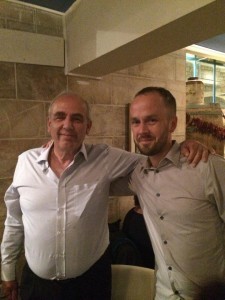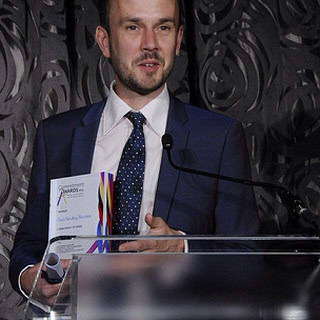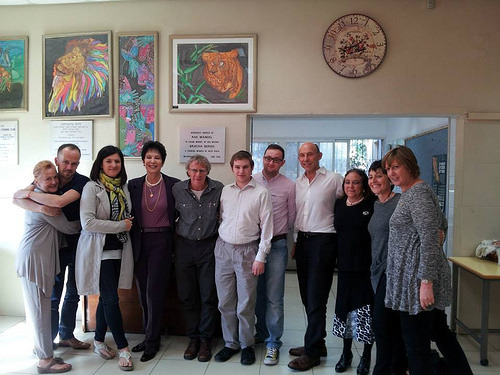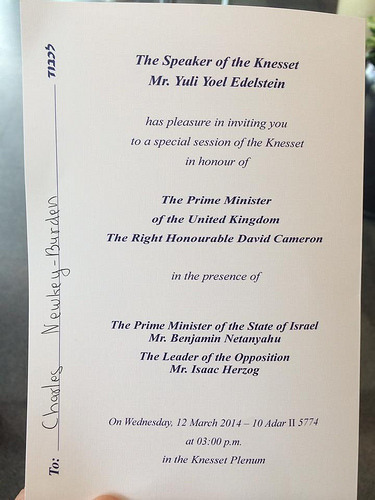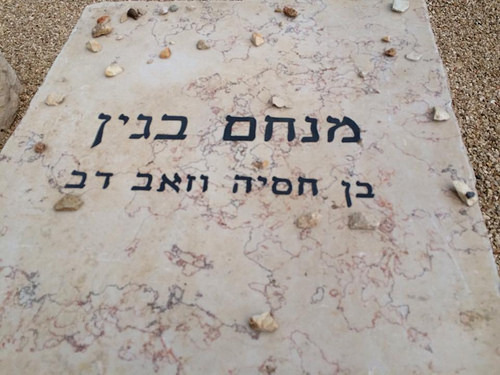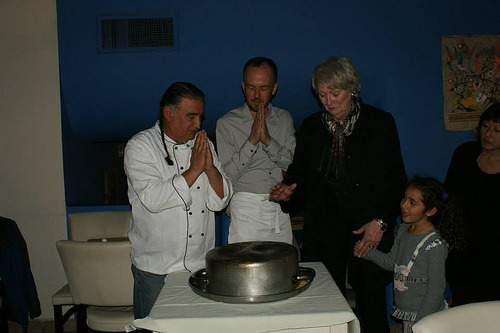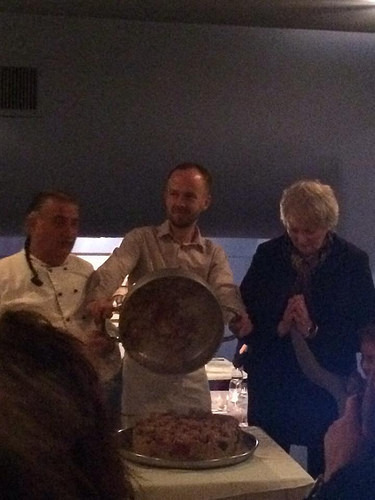Chas Newkey-Burden's Blog, page 5
March 27, 2014
Nobody’s perfect
Posted in Uncategorized
At dinner that night, they met Yoni Peres, the son of Israeli President Shimon Peres. “Wizo is a wonderful organisation for Israel,” he told them, adding that he had a particular British interest: “I support Chelsea.”
Well, nobody’s perfect. But it was lovely to meet you, Yoni. The above is taken from Charlotte Oliver’s feature about the recent Wizo trip to Israel. It appears in tomorrow’s Jewish Chronicle.
March 26, 2014
NaNachs: praying with joy
Posted in Uncategorized
Aww come on, you didn’t really think I’d forgotten about the NaNachs, did you?
I found this video in a recent NPR article about the NaNachs.
I do love the NaNachs. They remind me of one of my favourite Rabbi Nachman sayings: Pray with emotion, and God will forgive you. Pray with an attentive heart, and see all of heaven’s doors open before you. Pray with joy, and watch your requests ascend straight to God’s chamber.
PS – While we’re on a mystical vibe, here is my post about my recent visit to Safed.
March 24, 2014
The downside of rebuttal
Posted in Uncategorized
This is my latest column for the Jewish Chronicle.
It’s a familiar cycle. A politician makes an incendiary allegation against Israel. Pro-Israel advocates rush to issue defensive rebuttals. An almighty scrap develops, few give any ground, but the original allegation is repeated by both sides as the controversy drags on.
At least we stood up to them and challenged the haters, right? We showed we won’t be pushed around! Well, I used to think that way. I have done a bit of rebutting myself. But I’m no longer sure it’s always the wisest response. In fact, I wonder if mindless, knee-jerk rebuttal of every accusation Israel faces could be doing our cause more damage than good.
For boorish activists, careerist climbers and others obsessively involved on either side of this cultic debate, it is easy to forget that most people in Britain are not interested in Israel and the Palestinians. Why would they be? They are too busy making ends meet, fixing up their homes and looking after their kids to worry about a conflict thousands of miles away.
So when Israel-bashers shriek about “war crimes”, “apartheid”, and “organ harvesting”, their audience is usually marginal. They are more or less shrieking into a vacuum, save for a handful of committed cranks.
Then we get involved. When we challenge their lies, the first thing we do is repeat them to a wider audience. We shouldn’t flatter ourselves: the minutiae of our case for the defence is less memorable than the fact that we, too, have placed the name “Israel” in the same sentence as “war crimes”, “apartheid”, and “organ harvesting”. The “not” gets forgotten, but the allegation lingers in the collective memory of those who overhear the bickering.
Before he started ranting about Israel, Liberal Democrat David Ward was an obscure Bradford MP in a crumbling political party. Now, he knows which button to press to get in the headlines. He cannot believe his luck. The same goes for Pink Floyd’s Roger Waters. He was just a wrinkled rocker, remembered only by air-guitar-toting men of a certain age, before he started obsessively playing the anti-Israel card.
It’s not just the anti-Israel card that Waters and his ilk play – it’s us, too. They know their statements will provoke howls of outrage and rebuttal from Israel supporters. Another anti-Israel argument gets aired, and the name of its proponent gets plastered far and wide.
We are their unpaid foot soldiers. They do not win despite our defence – they win because of our defence. We’re so quick to put them and their bigotry centre-stage. That’s why Israel-bashing has become so fashionable. More than any other cause, it’s a no-brainer for the publicity-hungry, and we have helped make it so.
For robotic rebutters, madcap monitors and profiteers of doom, the race to respond is a sacred cow. Rebuttal fills their otherwise empty days with the electric glow of self-righteousness. Do the rest of us want to follow the path of the defensive activist, who responds to everything without thought, or the shrewd politician, who knows that some lies you challenge, some you let wither?
It is a tricky one to call. But before we rush to challenge – and therefore repeat – a particular anti-Israel slander, we should ask ourselves whether we are helping Israel, or whether we are actually becoming unwitting puppets for her bitterest enemies.
March 22, 2014
Amis: everything and nothing
Posted in Uncategorized
I am a big fan of Martin Amis. He is my favourite living author, and my second favourite author of all time (behind Jerome K Jerome).
Quite a while back I noticed that in interviews and speeches he often describes things as ‘sort of everything and nothing’. He seems to love describing things that way.
Well, I interviewed him once. It was agreed as a brisk, 15-minute interview about nuclear war in literature. I really hoped that he would use the phrase. The opening sentence of his first answer was: ‘Nuclear weapons – they’re sort of everything and nothing.’
What a guy. He will present a documentary on BBC4 this evening, called Martin Amis’s England. It’s had the chattering classes chattering all week, and I’m sure there will be further chatter on it in the days ahead.
In the meantime, here is a video of talk that he gave in 2007 alongside the late Christopher Hitchens. It was at a Jewish event and the pair speak about many topics including Israel, antisemitism, philosemitism and Saul Bellow.
The video is a little flickery for the first three minutes or so but stick with it. Both men are on fine form, oozing wit. My favourite parts are when Martin Amis reveals how he and his wife refer to their children, and Christopher Hitchens’ gag about a man whose job it is to watch out for the arrival of Moshiach.
Have a lovely day. I’m off to give another talk at Eton College.
March 19, 2014
The real prize
Posted in Uncategorized
Last summer, on my 40th birthday, two significant things happened. I started studying Zohar, and I found out I’d been nominated for an award. I didn’t realise at the time how connected these things were.
The news about the award came out of the blue. I got an email from the charity Wizo, telling me I had been nominated for an award called Commitment to Israel, and that I had been shortlisted as one of three finalists.
A month later Wizo told me I had won. They presented me with the award at a posh gala dinner in London and told me I’d be getting a free trip to Israel as part of the prize.
I was excited at the prospect of another Israel trip, and I felt so happy and proud to win the award. Then, my ego got to work. I had won an award. I was an award winner. How thrillingly important I must be!
When they took me to Israel, all that came crashing down. In a really good way.
We visited Wizo projects, starting with the Rainbow House in Haifa. For over 40 years the House has helped women from less privileged backgrounds to help themselves launch careers as beauticians.
Two women in particular, an Ethiopian called Goodei Abar and a Holocaust survivor called Ruth Galiliee, blew me away with their stories. Not just the stories. Their smiles made me cry.
Then we went to the WIZO Ahuzat Yeladim School, which is a therapeutic haven for children who suffer from behavioral or emotional problems. This magnificent institution saves and enhances the lives of vulnerable kids.
We met the project’s manager, Yossi Saragossi, a magnificent man with the wisdom of an elder, the spring (and hair) of a youth, and the love of an angel. He’s a dude, and he’s fifth from the left in this photo.
And so to Jerusalem, to Wizo’s flagship project, the Rebecca Sief Center for the Family. This phenomenal institution serves thousands of people in a variety of ways including day care for hundreds of toddlers and children, skills training for teenagers, and support for victims of domestic violence.
As we were shown around the building, a group of children smiled at us as they sang and danced to a Purim tune.
The volunteers and staff who run these projects are the ones who show commitment to Israel. I was humbled in the presence of the shiny, smiley faces of these beautiful beacons. They kept repeating the same message: to give is to receive.
Here is the connection. Two of the messages I keep taking from my Zohar study are how vital it is to deflate your ego, and that to give is to receive. How fitting that on the same day I had begun studying Zohar, I received an email about an award that would ultimately whisk me to Israel where my ego would be battered and where I would see, over and over, that to give is to receive. That was the real prize.
And then, having visited these projects, where the Zohar lessons were brought to life, I went to Tzfat, the home of Kabbalah, for the first time. And I felt reborn that day.
So life didn’t so much begin at 40 for me – it restarted. Thank you Wizo. Thank you Israel. Hugs and admiration to you all.
You can find out more about Wizo UK here. The World Wizo website is here.
March 17, 2014
Chaos and charm in Jerusalem
Posted in Uncategorized
Some invitations are an easy ‘yes’. This was one.
I was front row and centre of the public gallery as the Knesset descended into very entertaining chaos in front of David Cameron.
Some United Torah Judaism MKs walked out, other MKs heckled Bibi and each other. One was led away. Bibi visibly fumed, Cameron tried to keep a straight face, and I sat watching with a broad grin on mine. Two of the things I enjoy about Israel are the informality and the love of vigorous debate. I was having a lovely little time. Former Israeli PM Ehud Barak was sitting near us in the gallery. Natasha Kaplinsky was there, n’all.
I went to visit the resting place of my favourite Israeli leader, Menachem Begin. He rests on the Mount of Olives. I left two stones on his grave, one from me and one from OvG reader Simone, who asked in a recent comment for me to do that. Here’s to ya, MB.
We dined at the lovely Eucalyptus Restaurant. This oasis of charm and quirk is just a stroll away from the Jaffa Gate. Its biblical menu includes such wonders as ‘Jacob & Esau’s biblical red lentil stew’ and ‘Hubeza warm salad prepared in the style of the siege on Jerusalem’.
The restaurant’s finest asset is its head chef, Moshe Basson. He is prepared in the style of knockout charisma. I had a lovely chat with him about Kabbalah, and he even set us an inter-course task involving food and Gematria.
He asked me to join him in the centre of the restaurant to pray over the main dish.
And to present it to the restaurant.
What a day and night it had been in Jerusalem. Then we went back to Herzliya. I sat on the coach dreaming of the following day, when I would visit the holy city, Tzfat.
A guide to Safed
Posted in Uncategorized
This is a guest post from Laurie Rappeport
Chas’s recent visit to Safed, my hometown, prompted me to write and share a little bit about my town. I’ve lived in Safed for almost 30 years and worked as the coordinator of the Tourist Information Center here for 13 years. Sharing information about Safed is a passion of mine and I’m pleased to be able to expand on Chas’s article (and great photos).
For many years one of Israel’s most fascinating sites, Safed, was all but ignored by most tourists. The city is located up on a mountaintop in Israel’s northeastern panhandle and most tour guides didn’t think that their tourists would enjoy the sleepy, dusty town. In recent years however the number of visitors to Safed has grown as people look for a more spiritual component to their Safed trip. Today Safed is a mandatory stop on many tours for groups and individuals who come to explore the mystical and historic spots that are scattered throughout the Old City.
History
Safed is known as one of Judaism’s Four Holy Cities. The city rose to prominence as center of Kabbalistic learning in the 16th century when rabbis and Kabbalists made their way to Safed after fleeing the Spanish Inquisition. Safed became a center of Jewish mysticism and by the mid-1500s more Jews lived in Safed than in Jerusalem.
Safed experienced two significant earthquakes, one in the 18th century and the second, a devastating one, in the 19th century. These earthquakes caused landslides that reduced the city to rubble and although Jewish survivors returned to rebuild, the city never regained its 16th century prominence. Throughout the city visitors can see the tops of arches which indicate the presence of windows and doors of buried homes. Some of these rooms have been excavated and tourists can see them at the the Safed Tourist Information Center. There is also a 10-minute movie about the history of Safed at the Center.
Synagogues
Jews lived in Safed for thousands of years. Little is known of the early residents of Safed until the Crusader era when the Crusaders recorded the presence of Jews along with Moslem and Christian Arabs. When the first Jewish exiles began to arrive in the city after the Spanish Expulsion of 1492 they found a small backwater town but the town’s location, along the Acre-Damascus trade route, ensured economic security.
The earthquakes destroyed almost all of Safed’s original synagogues but a 19th century donor funded their restoration on their original sites, in their traditional styles. Those are the synagogues that are seen today throughout the Old Jewish Quarter.
Ari Ashkanazi
The Ari Ashkanazi synagogue was originally called the “Girigos” synagogue. It was established by refugees who had fled Spain to the Greek island of Girigos after undergoing forcible conversion to Christianity. This was a common during this era but the established Jewish community refused to accept converted Jews back into the Jewish world. The Girigos Jews built their synagogue on the then-outskirts of Safed. When Rabbi Isaac Luria — the ARI. a great Kabbalistic rabbi — came to Safed he chose to conduct his new pre-Shabbat service of psalms and songs in the field next to the Girigos synagogue. This service came to be known as the “Kabbalat Shabbat” and is today recited before Shabbat in synagogues and temples throughout the world.
Following the ARI’s death the the Girigos Jews were welcomed back into the mainstream community and the synagogue was renamed “Ari Ashkanazi.”
Ari Sepharadi
Prior to the ARI’s arrival in Safed in 1570 the Ari Sepharadi was called the “Eliyahu HaNavi” — Elijah the Prophet — synagogue. According to legend the Ari sat inside a small cave in the synagogue where he studied Kabbalah with Elijah the Prophet. After the earthquake of 1837 local residence believed that the synagogue was haunted and for many years no one entered the synagogue. The Baba Sali, a Moroccan Kabbalist, visited Safed in 1921 and performed a kabbalistic incantation to banish the spirits.
Abuhav
According to local legend the Abuhav synagogue was built in Spain by Rabbi Abuhav who then magically transported the building to Spain when the Inquisition threatened to destroy the synagogue. Other versions of the story claim that Rabbi Abuhav planned the synagogue in Spain and then built it in Safed.
The Abuhav synagogue is one of Safed’s most famous synagogues. It features a blue domed interior with kabblistic-inspired etchings. There are three Arks of the Torah which house the regular Torah scrolls which are used daily as well two old Torah scrolls which were written by 15th century Kabbalists Rabbi Ohana nd Rabbi Abuhav. The third ark once housed the Koran, a requirement that the 15th – 20th Ottoman Turks rulers imposed on all of their empire’s houses of worshop. Today the ark is a geniza and is used to store holy texts.
Yosef Caro Synagogue
Rabbi Yosef Caro a comprehensive summary of Jewish customs and laws, in Safed in the 16th century. According to the legend an angel — the Magid — guided him in this masterpiece as they sat together in the small cave of the synagogue.
The original Caro synagogue building is located below today’s Yosef Caro synagogue. It can be entered during morning hours.
The present Yosef Caro synagogue is built in the Sepharadi tradition. Thel “bima” — podium – sits in the center of the synagogue and seats surround the bima. An ancient geniza is located behind glass walls along the synagogue’s perimeter.
Old Safed Cemetery
Jewish tradition relates that prayers which are recited near a gravesite of a holy or righteous person are transmitted straight to heaven. Many visitors in Safed descend into the Safed cemetery where they can pray at the gravesites of the ARI, Rabbi Yosef Caro, Rabbi Alkabetz, Rabbi Alsheich, Rabbi Ya’akov Beirav, Rabbi Haim Vital, Rabbi Moshe Cordevero and other great rabbis and kabbalists.
The cemetery also contains gravesites which are believed to date back to the Talmudic period including graves of Hannah and her Seven Sons, Hoseah the Prophet and Rabbi Pinchas Ben Yair.
Ari Mikve
Along the mountainside on the southern side of the cemetery, the ARI mikve draws men (women are not allowed) year-round. Legend states that the mikve was once used as a spring where bodies were washed before buriel. When the ARI died, he spoke as his dead body was being washed in this spring. This gave rise to the belief that miracles occur to those who immerse in the Ari mikve’s waters. A word to the wise, especially for visitors who come during winter months — the ARI Mikve is not heated.
Art
Safed began to expand in the mid 20th century following the War of Independence. Among the immigrants who settled in the city were some of Israel’s finest artists. These artists established a bohemian artists community in the area where tourists could wander to see their work. Today the majority of the galleries have migrated to Josef Caro Street in the Old Jewish Quarter where tourists can see various types of Judaica and Israel-inspired art. A number of Kabbalistic artwork is displayed by American born Safed artists including Daniel Flatauer (pottery), Sheva Chaya Servetter (glass blowing and watercolors), Dovid Friedman and Avraham Lowenthal.
Laurie Rappeport lives and works in Safed, Israel. She was the coordinator of the Safed Tourist Center for 13 years and continues to promote Safed to visitors from throughout the world. Laurie also teaches Judaism and Israel-related curriculum online and is involved in creating elearning materials for homeschooling students.
March 15, 2014
Beautiful, beautiful Haifa
March 14, 2014
Sweet city of my dreams
Posted in Uncategorized
I’ve wanted to visit Tzfat for many years. Since I started reading Zohar in full nine months ago, I’ve grown keener on the idea. Tzfat has been the city of my dreams.
Yesterday, I went there. We drove through heavy rain towards Tzfat and as we drew near, the mystical city was shrouded in mist. It was mistical, too.
Then the mist lifted and, as we pulled up into the car park, the rain suddenly stopped. Finally, I was there.
I was enchanted by the magical, winding lanes of the city.
I had a fascinating chat with local artist David Friedman about his art, his life and also Zohar study and meditation techniques.
I also visited the Kabbalah Centre where I met Eyal Riess – a wonderful and friendly guy. He found the name of my blog very amusing, which is as it should be.
Then we got back into the car. The moment we did, it started to rain again. We drove to Peki’in, to visit the famous cave of Bar Yochai. According to legend, this cave is where Rabbi Shimon Bar Yochai hid from the Romans for 13 years. While he was there, it is said, he composed The Zohar. When we arrived, the rain stopped. Visiting the cave seemed magical to me – I felt reborn as I emerged.
Tzfat is mystical, magical and artistic. It’s so friendly, too. The mountain air is plentiful and refreshing. I recommend a visit. When I look back on mine, it seems like it was a beautiful dream. Have a happy weekend, everyone.
March 11, 2014
Beautiful people
Posted in Uncategorized
Today in Haifa I met three inspiring women at Wizo’s Rainbow centre.
On right is Goodei Abar. Growing up in Ethiopia, she was expected to marry as a child. Instead, she travelled to Israel at 12 years old. When she arrived, she held a pen for the first time. ‘Finally I could be a child,’ she said with a huge smile.
On the left is Amar Awad, a Christian Arab woman whose life was turned around by the Centre. It helped her start a business in the beauty industry. ‘This centre is like a family,’ she said.
In the middle with me is Ruth Galiliee. She survived the Auschwitz and Bergen-Belsen camps. She has volunteered in Israel for 34 years. We had a hug and she told me: ‘I don’t feel poor because I’ve got a big family, including 11 great-grandchildren. I hope to volunteer for many years to come.’
Beautiful people, beautiful Israel. The desert is blooming.
Chas Newkey-Burden's Blog
- Chas Newkey-Burden's profile
- 23 followers


